Physical Address
304 North Cardinal St.
Dorchester Center, MA 02124
The impact of major ablative surgery for cancer in the head and neck region can be devastating for the patient, aesthetically and often functionally. Reconstruction of oncologic defects is necessary to restore function and appearance in an effort to achieve total rehabilitation ( Fig. 17.1 ). Psychosocial, vocational, and emotional counseling may also be necessary for total recovery. Examples of aesthetic considerations include contour, appearance, and expression of the face. Restoration of oral competence also is necessary for patients who have undergone major surgery of the oral cavity and oropharynx. Functional concerns that warrant consideration include speech, mastication, and deglutition.
Ablative surgery to treat cancer leads to loss of soft tissue and bone ( Fig. 17.2 ). Soft tissue defects include missing epithelial (dermal or mucosal) lining as well as loss of volume of underlying soft tissues. Before any replacement of tissues takes place, the reconstructive surgeon must first prioritize the functional and aesthetic concerns, and then decide what tissue must be replaced or repaired. An assessment of available tissue donor sites then ensues. Ideally, like tissues should be replaced with like. For example, missing bone should be replaced with an osseous reconstruction; however, the need for bone reconstruction depends on the site and extent of bone resection and may not be possible or necessary in all instances. Special consideration is also required for reconstruction of resected nerves, blood vessels, and cartilage.
The surgical defect created by resection of either a primary or a metastatic tumor in the head and neck region can often be repaired by primary closure if the tissue loss is modest. However, if primary closure is not feasible, then viable tissue should be introduced to repair the surgical defect. Such tissue may be mobilized as a local or regional flap, transferring adjacent tissues from the head and neck region. Alternatively, reconstruction may require free tissue transfer from a distant donor site. Therefore flaps available for reconstruction of defects in the head and neck region may be classified as local, regional, or distant depending on their relationship to the area being reconstructed.
The viability of any flap depends on its type of blood supply. In general, axial flaps are more reliable because they are perfused by a predictable, named vascular pedicle. The width-to-length ratio of an axial flap may be as much as 1 : 5 or more depending on the particular flap chosen and its associated blood supply. In contrast, random flaps are less reliable because they are perfused by a smaller subdermal plexus of vessels. The narrower the base of the flap, the less likely a random pattern of circulation can support the tissue.
A better understanding of vascular anatomy, regional circulation, and the angiosome concept has resulted in the increase in availability and dependability of flaps with a wide range of applications in reconstruction of various defects. Flaps are most reliable when based upon a known vascular pedicle (i.e., axial pattern). As a result, muscle and myocutaneous flaps used for reconstruction are based on named vessels or their perforating branches, whether used as a pedicled regional flap or as a distant free flap. Microsurgery has evolved significantly, and the use of free flaps has become routine with the advent of operating microscopes and microsutures.
Special considerations are required for reconstructive surgery in each specific region of the head and neck. As such, these topics are approached individually.
The skin of the scalp, face, or neck can often be replaced easily with a skin graft or local flaps. However, when extirpation involves the underlying soft tissues with creation of surgical dead space, more complex reconstructive efforts with pedicled or free flaps are required. The use of regional muscle/myocutaneous flaps, such as the pectoralis major flap, is a common solution. Alternatively, free flaps applicable in these situations include the radial forearm, omentum, anterolateral thigh, latissimus dorsi, scapula, rectus abdominis, and groin flaps.
Following major resections of the paranasal sinuses, orbit, or skull base, certain situations mandate reconstruction. For example, dura and intracranial contents should be separated from the nasal cavity after skull base surgery. Likewise, support of the globe should be planned whenever the orbital floor is resected. In addition, replacement of soft tissue bulk and overlying skin is the standard management of major three-dimensional composite defects. Repair of the skull base can be performed without bone by using galeal pericranial or a free flap. Reconstruction of the floor of the orbit may be accomplished with use of a free osteocutaneous flap or by combining a bone graft with a soft tissue free flap, depending on the circumstances. If alloplastic material such as titanium mesh is used to repair the floor of the orbit, then adequate soft tissue coverage should be provided to avoid exposure and extrusion of the alloplastic material. Preoperative planning requires consultation with a maxillofacial prosthodontist for appropriate prosthetic support. Consideration should be given to the use of computer-aided design/computer-assisted manufacturing (CAD-CAM) technology where complex bone reconstruction is required. Examples of these are mandible reconstruction and maxillary reconstruction. On occasion, rehabilitation is accomplished by prostheses alone instead of reconstructive surgery to achieve the desired result ( Fig. 17.3 and Fig. 17.4 ).
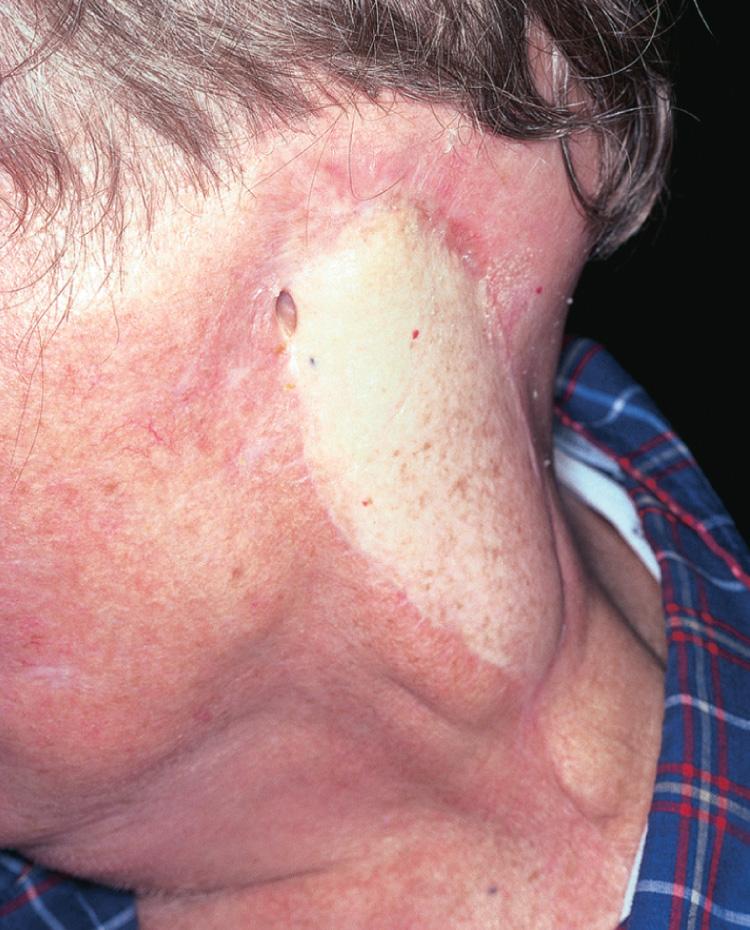
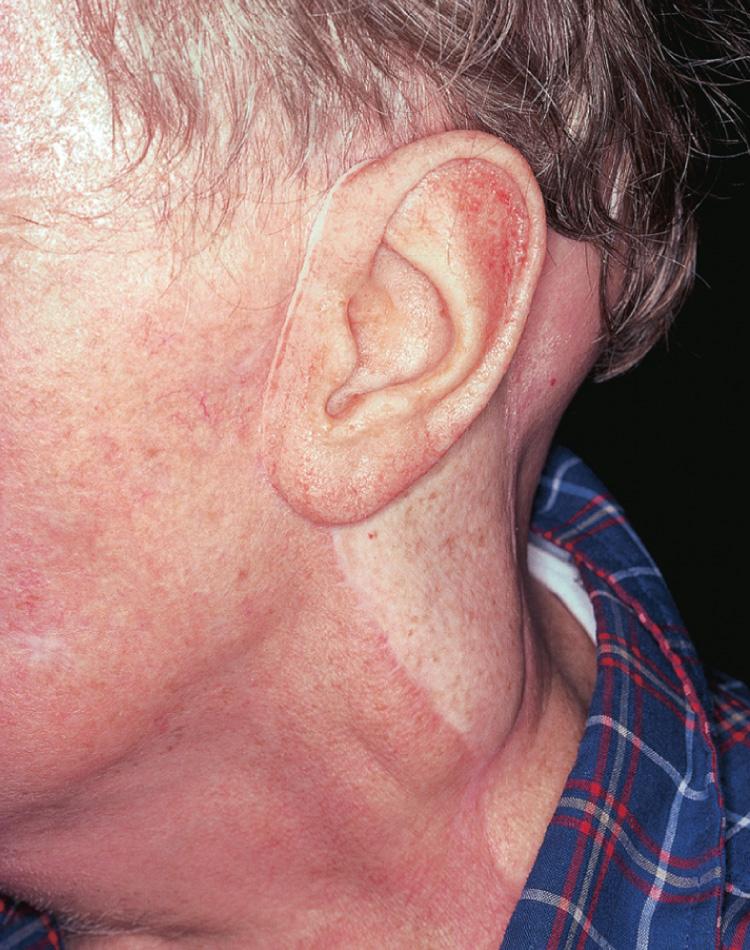
The goals of oral cavity reconstruction include both functional and aesthetic restoration. Major ablative surgery in the oral cavity may result in an oral cripple if appropriate efforts are not made to reconstruct the surgical defect and rehabilitate the oral cavity with restoration of removable or fixed implant-based dentation ( Fig. 17.5 ). The components of functional restoration are oral competency, clarity of speech, mobility of the tongue, mastication/occlusion, bolus transport, lip support, as well as prevention of nasal regurgitation and aspiration. Aesthetic considerations include restoration of facial height, soft tissue contour, chin prominence, and lip support.
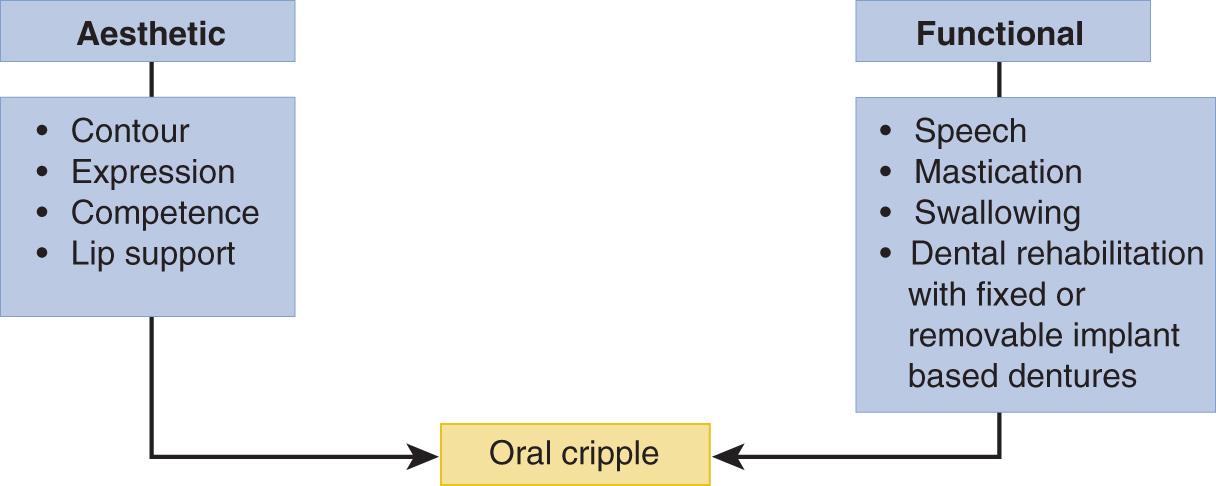
Major ablative surgery for tumors of the oral cavity may result in loss of mucosa, submucosal soft tissues, underlying musculature, overlying skin, and/or adjacent bone. Small, superficial defects of the mucosa and underlying soft tissues in the oral cavity can in some cases be repaired by primary closure, a local mucosal/musculomucosal flap, or a split-thickness skin graft. More complex or extensive resections require tissue transfer with regional or distant flaps.
Resection of the upper alveolus may be satisfactorily reconstructed with a dental prosthesis. However, if permanent obliteration of the communication between the oral cavity and nasal cavity or maxillary antrum is needed, then a free flap is the best option. In reconstruction of the upper alveolus/palatal defects, CAD-CAM technology should be utilized if bone reconstruction is planned for accurate restoration of the contour of the face and alveolar arch. Resection of the lower alveolus with a marginal mandibulectomy does not typically require replacement of bone. However, dental rehabilitation is difficult, and implants are impossible following marginal mandibulectomy. On the other hand, a segmental mandibulectomy, requires reconstruction of the resected bone with a composite free flap. Here again, CAD-CAM technology is very applicable for accurate and expeditious reconstruction with a free bone flap.
The need for immediate reconstruction of pharyngeal defects cannot be overstated. The goal should be to restore the ability of the patient to resume oral alimentation as soon as possible after resection of the tumor. Reconstruction of the surface lining of the pharyngeal wall resulting from transoral excision of superficial mucosal lesions does not require any major reconstructive effort. In these cases, the surgical defect is left open to heal by secondary intention. On the other hand, full-thickness resection of the pharyngeal wall requires reconstruction with use of a regional myocutaneous flap or a free flap, keeping in mind that the eventual goal of such a reconstruction should be to restore deglutition without aspiration or airway obstruction.
When a laryngectomy is undertaken in addition to pharyngectomy, the reconstructive choices depend on whether there is partial or total loss of the hypopharyngeal circumference. Partial hypopharyngeal defects can be repaired with a pectoralis major myocutaneous flap, a supraclavicular fasciocutaneous flap, or a free flap. When circumferential resection of the hypopharynx is undertaken, the choice of flaps depends on the length of the resected segment. A short, circumferential hypopharyngectomy segment limited to the cervical region is reconstructed with either a free segment of jejunum or a tubed fasciocutaneous free flap. However, when the hypopharyngeal resection extends to include the cervical esophagus, then the options are colon interposition, free flap, or gastric pull up. Complication rates of up to 15% are reported following gastric transposition. Clearly, the goals of reconstructive surgery in this setting are to recreate a satisfactory alimentary conduit, prevent stricture formation, and avoid functional obstruction caused by redundant soft tissue.
Small superficial defects of the mucosa or skin that are not amenable to repair by primary closure or rearrangement of adjacent tissue are considered for reconstruction with either a split-thickness or a full-thickness skin graft. Full-thickness skin grafts tend to have a better cosmetic appearance and less secondary contracture than split grafts; however, they are limited in size. Common full-thickness donor sites for head and neck defects include the retroauricular and supraclavicular areas. Split-thickness grafts are abundantly available but can undergo significant contracture, which can limit movement of functional areas such as the eyelids or tongue. Because split grafts are thinner, including only portions of the dermis, the metabolic requirement for healing is less than that for full-thickness grafts. As such, for poorly vascularized areas, split grafts are preferred. In general, for external skin coverage, skin grafts are best applied to the parts of the scalp or face that are relatively immobile. Thus skin grafts are most suitable for defects of the scalp, temple, nasal bridge, external ear, and postauricular region. A typical example is excision of a superficial melanoma from the skin of the bridge of the nose. Generally, surgical defects after excision of melanoma are not repaired immediately until the final paraffin section report from pathology shows clear margins. In the interim, the surgical defect is covered with hemostatic dressings, such as Surgicel ( Fig. 17.6 ). Cheek skin was advanced over the lateral portion of the defect, and a full-thickness skin graft from the posterior triangle of the neck was used to close the remaining defect ( Fig. 17.7 ). Occasionally, a full-thickness skin graft may be used, even on mobile parts of the face, if resection of a lesion leads only to skin loss that cannot be repaired in a more aesthetic manner ( Fig. 17.8 ).
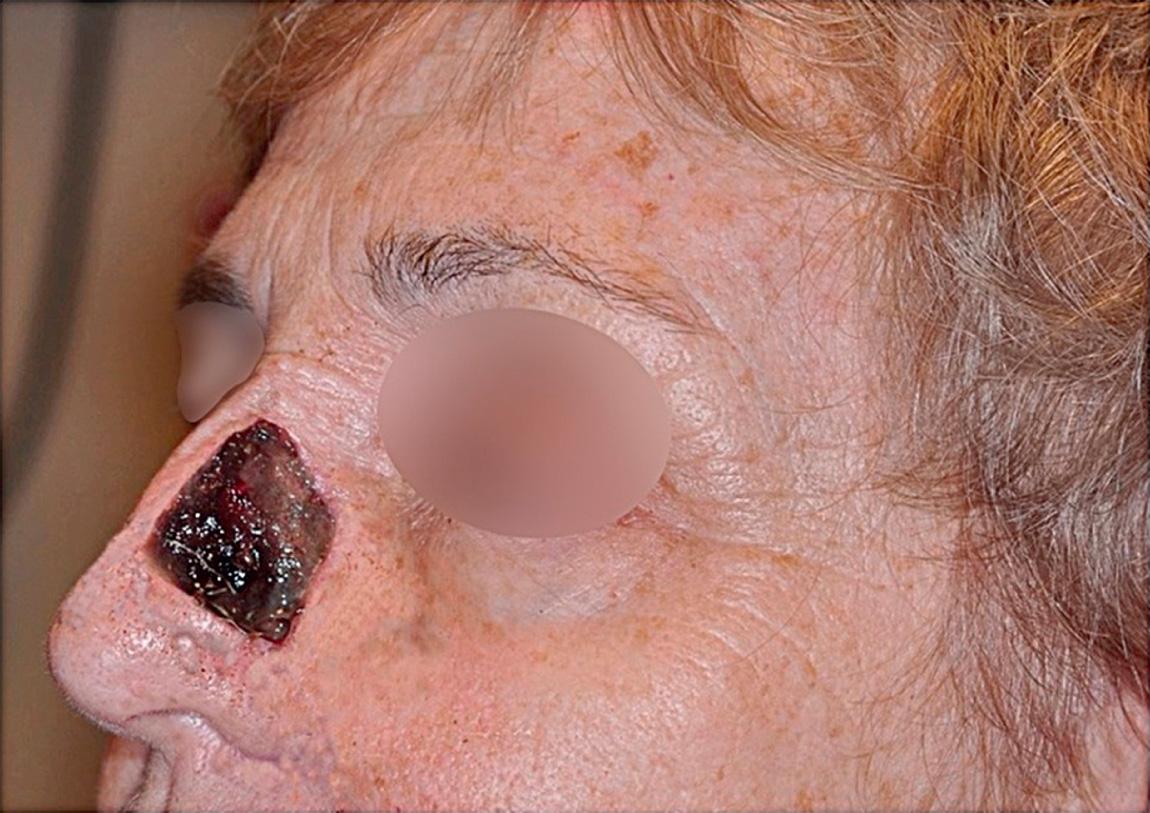
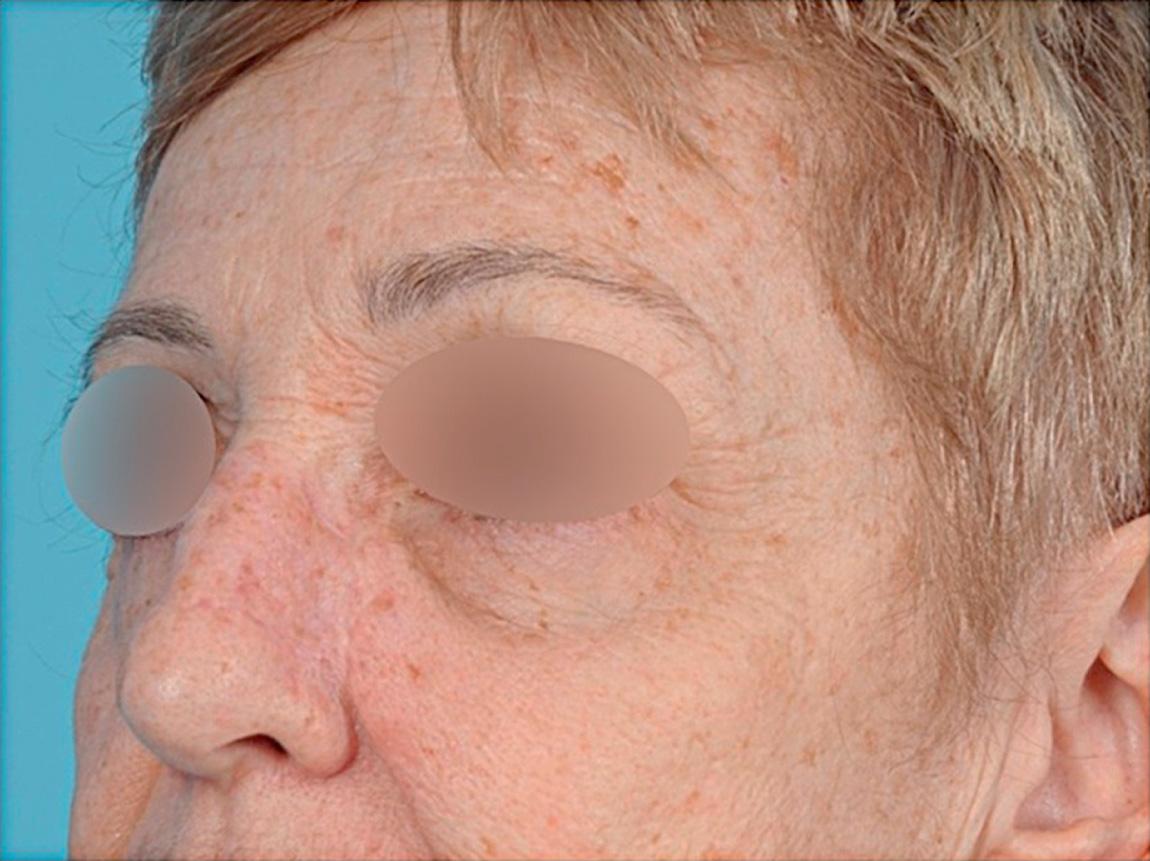
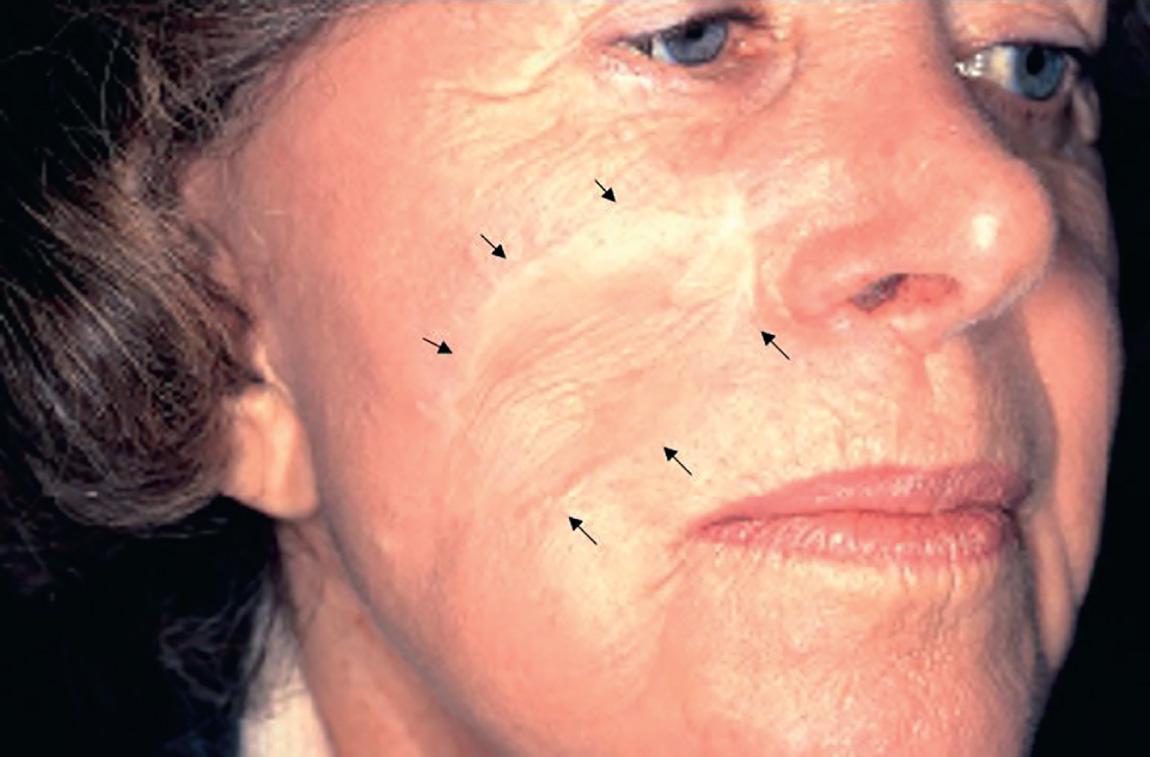
Skin grafts similarly may be used in the oral cavity when the mucosal defect is either too large to heal by secondary intention or is likely to cause contracture and functional disability. This situation is particularly true in the case of superficial defects of the anterior floor of the mouth or buccal mucosa. When used in the oral cavity, it is quite common for portions of the skin graft to slough in the immediate postoperative period, but as long as the deeper layers of the skin graft remain viable, eventual epithelialization occurs with excellent functional results. Lesions suitable for skin graft repair in the oral cavity are shown in Figs. 17.9 through 17.12 .
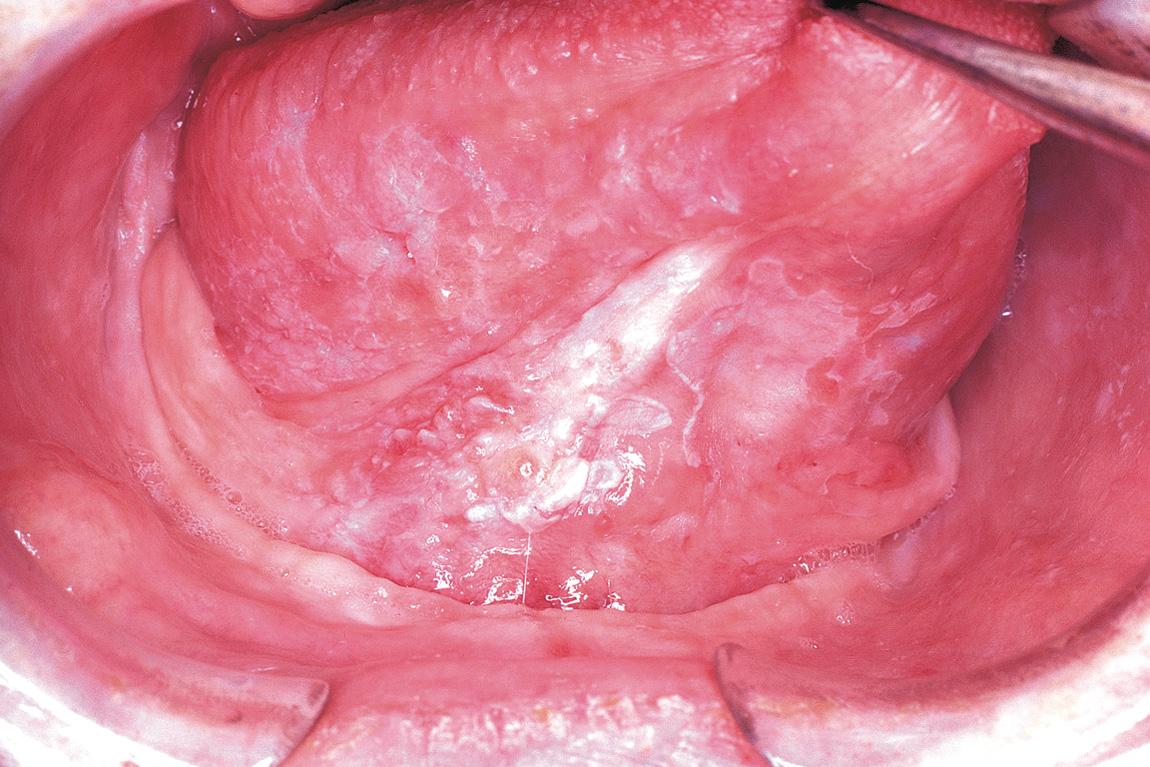
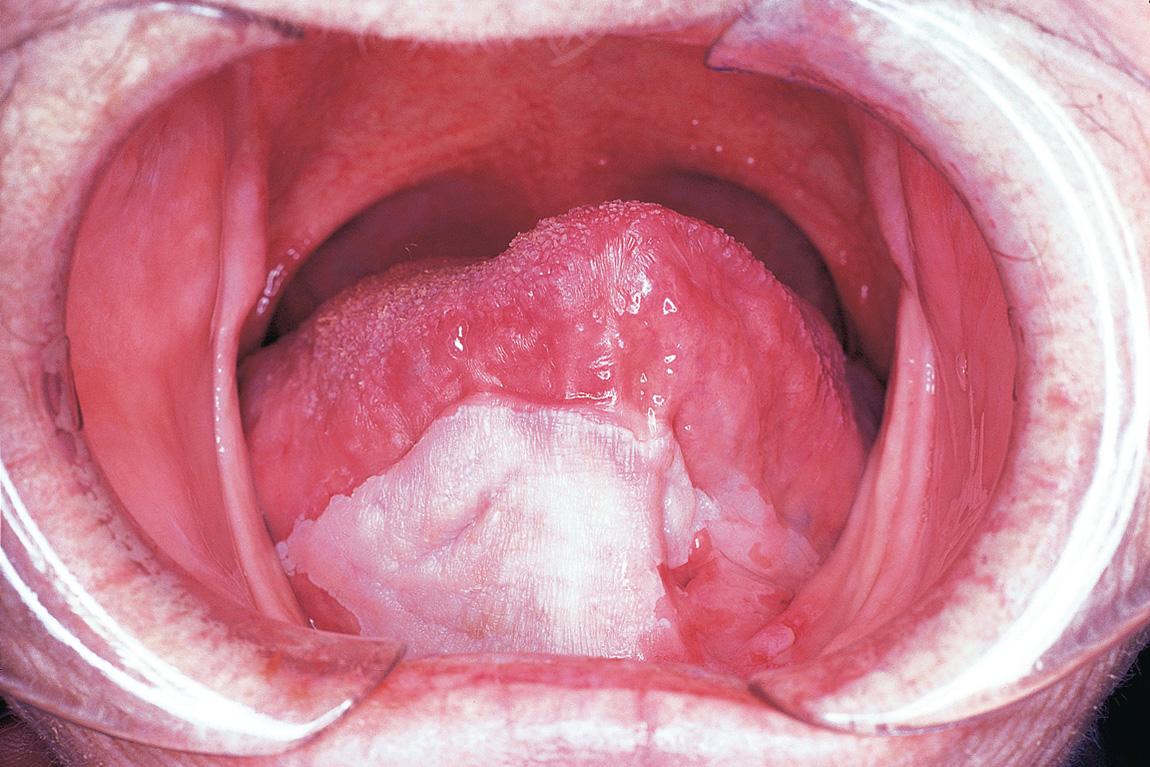

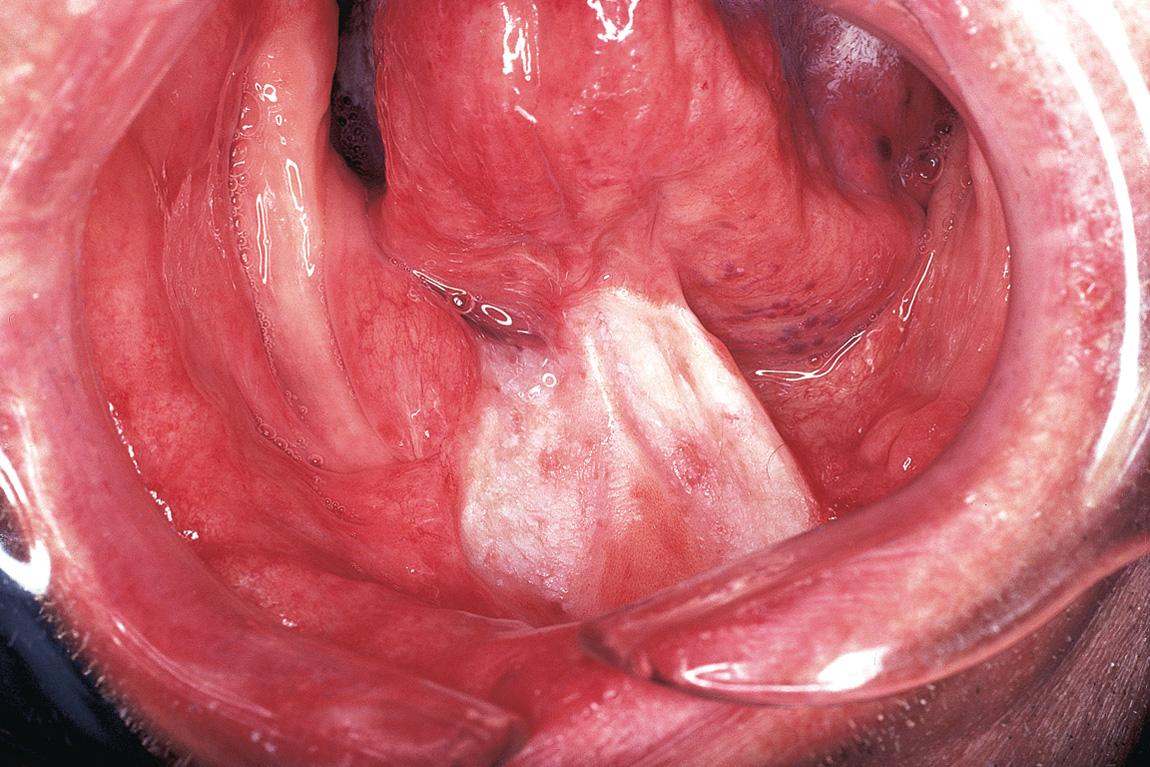
Adjacent tissues may be elevated to reconstruct small surgical defects that cannot be repaired primarily. Also known as a local flap, adjacent tissues may be mucosal or cutaneous, depending on the location and the tissue requirements. Examples of mucosal flaps for intraoral repair are the tongue flap, the pharyngeal wall, and facial artery musculomucosal (FAMM) flap. However, because these flaps have a limited number of specific applications, surgeons are often unfamiliar with technical aspects of harvest, and these options may be perceived as unreliable. On the other hand, a palatal mucoperiosteal flap that derives its blood supply from the palatine artery is quite reliable in the repair of small through-and-through palatal defects or for the repair of a postsurgical oronasal fistula.
Many local cutaneous flaps are available for repair of surgical defects of the scalp and skin of the face and neck. Local flaps are preferable for repair of skin and soft tissue defects on the face because of superior color match and skin texture. The nasolabial flap is a commonly used axial local skin flap. Adjacent tissue transfer of skin flaps with a random blood supply (e.g., using cheek advancement, rhomboid, or bilobed flaps) is often useful for small defects of the face and neck when adjacent mobile skin is accessible (see several examples of local flaps in Chapter 3 ). A few regional fasciocutaneous flaps are available in the head and neck region for coverage of surgical defects that cannot be repaired by either primary closure or adjacent tissue transfer. Frequently used regional flaps include the deltopectoral, supraclavicular, cervical, and forehead flaps.
With the availability of free flaps, the popularity of regional cutaneous and myocutaneous flaps has declined, except for specific indications, such as the forehead flap for nasal reconstruction. Often the aesthetic and functional morbidity resulting from regional cutaneous flaps in head and neck reconstruction can be avoided by the use of free flaps. Regional flaps are easy to elevate, and the surgical defect can be reconstructed expeditiously. Consideration should be given to the availability of regional flaps before planning reconstruction with a free flap.
Regional cutaneous flaps are skin flaps that are available in the head and neck region for transfer from one area to another to cover a surgical defect that cannot be repaired by primary closure or by advancement of local tissues or local flaps. The most frequently used regional cutaneous flaps are the anterior or posterior cervical flap, the deltopectoral flap, the forehead flap, and the supraclavicular artery flap. The forehead flap is rarely used because of its significant donor site aesthetic morbidity. The blood supply to the forehead flap is axial, and the blood supply to the cervical flap is random. The blood supply to the deltopectoral flap is axial in its proximal part and random in its distal part. The blood supply to the supraclavicular artery island flap is axial from a branch of the transverse cervical artery.
The cervical flap is a regional flap with a random pattern blood supply. The width-to-length ratio therefore is 1 : 2, or at most 1 : 3, and thus, only a limited amount of skin is available. If a cervical flap of large width is used, a skin graft may be required to cover the donor site. The flap may be based superiorly or posteriorly and thus may be oriented vertically or transversely. When the skin of the anterior aspect of the neck is used, it is called the anterior cervical flap, and when the skin of the posterior aspect of the neck is used, it is called the posterior cervical flap or Mutter flap. The cervical flap generally is used to cover defects of the skin and soft tissues of the face and neck.
Become a Clinical Tree membership for Full access and enjoy Unlimited articles
If you are a member. Log in here